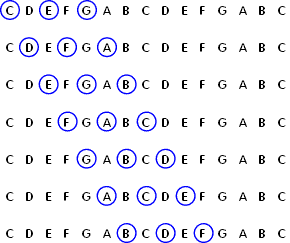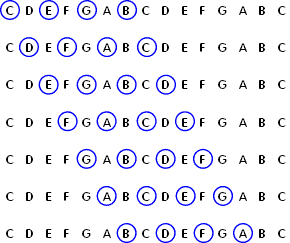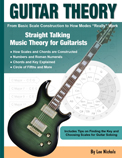Chords and Key Explained
Chords in the key
When we say a song or piece of music is in a particular key, it usually means that all the chords are derived from one scale type. For the moment it's best to take that as a loose description because there are a few things to think about here. The chords alone won't always tell the full story, for instance, a chord progression containing only the chords F, C and Dmin could belong to the key of F major or C major.
Let's begin by understanding how a bunch of different chords can all belong to one scale.
So far we have learnt that chords are built by stacking scale intervals in thirds from the root note. We can however treat each note in turn as the root note to find all the different chords that can be derived from the notes of one scale. In the key of C major for instance, up until now, we have only been concerned with all C chord variations.
We can easily find all the triads that belong to the key of C major by stacking third scale intervals, starting each note in turn from the C major scale. The diagram below shows us how.

This gives us seven triads that all belong to the key of C major. We can figure out what chord each one is by associating each root with it's relative scale. For example, the second chord in the sequence starts with a D so we can use the D major scale to find out what kind of chord it is, using the formulas we have discussed so far. For this then, we will need to know how the notes D, F and A relate to the D major scale.
The notes in the D major scale are D E F# G A B C#. We know already that the formula for the major triad is 1-3-5, which in D major would give us the notes D F# A. Therefore D, F A with respect to the D major scale must be 1-b3-5. By now you should recognise that as a minor triad. So the second chord in the key of C major is D minor.
The third chord has the notes E, G and B, likewise we will use the E major scale to figure out what kind of "E" chord it is. The notes belonging to E major are: E F# G# A B C# D#. So the notes E, G, B would come from the chord formula 1-b3-5 which is also a minor triad. The chord therefore is E minor.
If we carry on using this idea we will end up with the following chords that share notes belonging to C major.
- C Major
- D Minor
- E Minor
- F Major
- G Major
- A Minor
- B Diminished
The same idea applies to extended chords as you can see in the diagram below.

The resulting chords would be:
- C Major 7
- D Minor 7
- E Minor 7
- F Major 7
- G Dominant 7
- A Minor 7
- B Half Diminished (Bmin7b5)
I won't carry on with lengthy details, the above gives you the idea of how the chords are figured out but the good news is we don't need to do this kind of mathematics every time we want to know what chords belong to what key. As long as we know the scale notes then we can use a simple formula to find the chords in any major key. For this we use the chord numbering system.
Kindle book available from Amazon
Guitar Theory: Available on Kindle
Learn music theory that's worth knowing
Music theory can be complicated but we need to know it if we want to make sense of everything and improve our guitar knowledge and playing.
My latest book focuses mostly on the things that are really worth knowing, not so much on the rest. Start making sense of chords, scales, modes and finding the key to help you be more creative on the guitar.
Level: Advanced beginner and up.
Author: Lee Nichols Creator of www.guitar-chords.or.uk
(Sponsored Ad)
This website earns advertising commissions. To find out more about cookies, privacy and how we use advertising, please read our Advertising Disclaimer
Contact Info - Cookie and Privacy Policy
Copyright © 2007 - 2024 www.guitar-chords.org.uk


